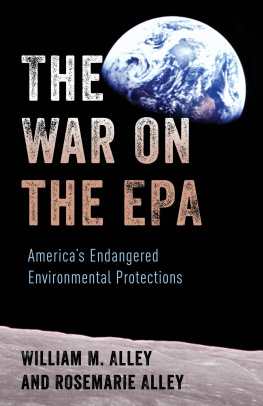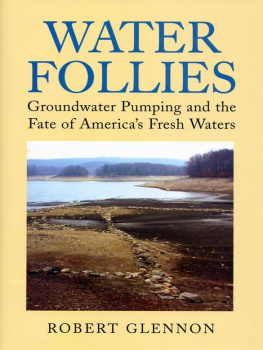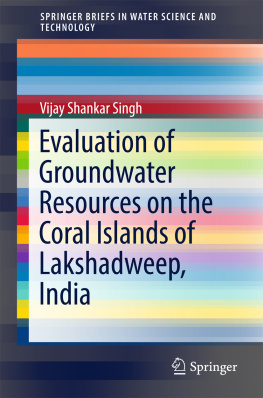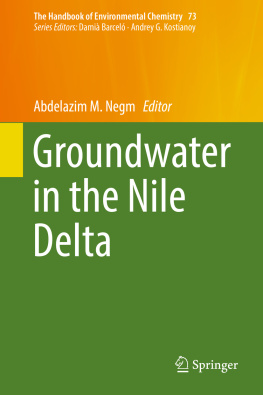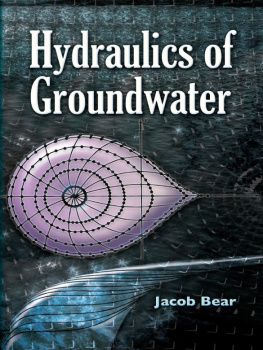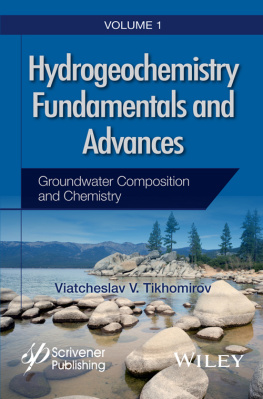High and Dry
High and Dry
Meeting the Challenges of the Worlds Growing Dependence on Groundwater
William M. Alley and Rosemarie Alley

Published with assistance from the foundation established in memory of Philip Hamilton McMillan of the Class of 1894, Yale College.
Copyright 2017 by William M. Alley and Rosemarie Alley.
All rights reserved.
This book may not be reproduced, in whole or in part, including illustrations, in any form (beyond that copying permitted by Sections 107 and 108 of the U.S. Copyright Law and except by reviewers for the public press), without written permission from the publishers.
Yale University Press books may be purchased in quantity for educational, business, or promotional use. For information, please e-mail sales.press@yale.edu (U.S. office) or sales@yaleup.co.uk (U.K. office).
Designed by Mary Valencia.
Set in Minion type by Westchester Publishing Services.
Printed in the United States of America.
ISBN 978-0-300-22038-4 (hardcover : alk. paper)
Library of Congress Control Number: 2016949267
A catalogue record for this book is available from the British Library.
This paper meets the requirements of ANSI/NISO Z39.481992 (Permanence of Paper).
10 9 8 7 6 5 4 3 2 1
Image of hand pump on .
To our grandchildren, Oliver and Julia.
May there be plentiful and clean groundwater for them,
their children, and their grandchildren.
Contents
Acknowledgments
This book would never have been written without the help and insights of many individuals who care about groundwater and its role in peoples lives and the environment. Joseph Calamia at Yale University Press made many invaluable edits and suggestions and guided us through each step in the publication process. Samantha Ostrowski helped with the figures and manuscript preparation. Julie Carlson gave the book a thorough copyediting. Mike Campana and Mark Giordano read a draft and provided many useful comments and suggestions. We are grateful for their insightful reviews. Sharon Megdal patiently taught us about the complexities of Arizona water. Kathleen Ferris, Paul Polak, Holly Richter, and Marvin Glotfelty all generously gave their time for interviews. Joe Ayotte, Mark Borchardt, Tom Cech, Devin Galloway, Rochelle Holm, Randy Hunt, Dick Jackson, Laurel Lacher, Stan Leake, Jim Leenhouts, Alan MacDonald, Rebecca Nelson, Laurie Rardin, Michelle Sneed, Paul Susca, and Pietro Teatini commented on various chapters and helped with fact-checking. Any errors that remain are ours alone. Kenley Bairos, Nathaniel Delano, and Sally House provided assistance with key illustrations. Finally we appreciate the contributions of hydrologists with the U.S. Geological Survey and members of the National Ground Water Association, with whom weve had numerous productive discussions.
1
Beyond Rain
Heaven is under our feet as well as over our heads.
Henry David Thoreau
In November 2007, Georgias governor, Sonny Perdue, stood behind the podium at the state capitol and gazed at the crowd. Hundreds of people from all across the state had traveled to be here on this late fall day. The choir ended their hymn. Silence ensued. All eyes were riveted on their governor.
Perdue stepped to the microphone and began to speak. Weve come together here simply for one reason and one reason only: To very reverently and respectfully pray up a storm... Its time to appeal to Him who can and will make a difference.
Members of the secular Atlanta Freethought Society gathered at the edge of the crowd, staunchly protesting this public prayer vigil. Ed Buckner, who had organized the protest, explained the societys views to anyone willing to listen: The governor can pray when he wants to. What he cant do is lead prayers in the name of the people of Georgia.
Can or cant, in the minds of most Georgians division of church and state was far from the issue. The southeastern United States was in the grip of one of the worst droughts in decadespossibly in a century. Parts of the southeast hadnt seen normal rainfall for a year and a half. Some areas were forty inches, basically a years worth of rain, below normal. Rivers had sunk to dangerously low levels. The boat ramp at Lake Lanier reservoir looked like a diving board. The drought was now threatening public water supplies.
The citizens of Georgia already had heeded the governors plea for strict water conservation. After declaring a state of emergency in much of the state, Perdue had battles to fight. First he filed suit against the U.S. Army Corps of Engineers, the federally appointed agency that basically calls the shots on reservoirs in the eastern United States. The governor wanted the Army Corps to reduce the amount of water being released from Georgias Lake Lanier for Alabama and Florida (and downstream endangered species). The Corps flatly refused. He appealed to President George W. Bush to put some pressure on the Corps, but the president wasnt of a mind to anger all those voters downstream in Florida. Finally, Perdue met with the respective governors to try to work out some kind of deal. But the only thing they accomplished was a further escalation of the tri-state water war that had been alternately simmering and boiling for nearly two decades. At this point, it seemed there was only one thing left to try. And so the governor prayed.
Two weeks earlier, a gospel concert dedicated to rain had attracted hundreds at an Atlanta church. Days later, a prayer rally at a high school football stadium in Watkinsville, Georgia, drew another large crowd. Nor was Perdue the first governor to try prayer. In July, Alabamas governor, Bob Riley, had declared an entire week Days of Prayer for Rain. It didnt work. By now, worry had turned to fear.
Battles over interstate water are a business-as-usual part of life in the arid western United States, but Easterners have tended to take their water wealth for granted. In the past few decades, this has begun to change. The fastest-growing eastern cities need additional water supplies and are discovering the difficulties of trying to secure water thats already allocated. One of these cities is the Belle of the Old SouthAtlanta, Georgia.
Since the 1970s, Atlantas spectacular growth has been the driving force behind the battle officially dubbed the Water War of the South. The seeds of this conflict go back to the 1950s when the dam that created Lake Lanier was constructed. Lying less than fifty miles (eighty kilometers) north of Atlanta, the lake was to supply much of the citys wateralong with allocations for the downstream states of Alabama and Florida. When these allotments were being discussed, Atlanta was still a small, leisurely paced, southern city. Having no way of reading the tea leaves, much of Lake Laniers water was dedicated to hydropower.
This situation changed in the 1970s, as Atlantas population began to explode into a large metropolitan area and state officials realized they needed more water. The problem was, that big reservoir (almost twice the size of Manhattan) in their backyard was already spoken for. So they turned to Congress. Under its constitutional authority to regulate interstate commerce, Congress authorized the U.S. Army Corps of Engineers to study ways to supply that water.
In 1989, the Corps announced that it would reallocate some of the water stored for hydropower in Lake Lanier for Atlantas public supply, basically doubling its allotment. Naturally, Georgians heartily applauded the Corps decision. It was plain as day that they had a right to the water in their own state. But the people of Alabama and Florida were outraged. They had their own population growth and economic goals to consider. Freshwater flows from Lake Lanier also were essential to Floridas booming oyster industry in Apalachicola Bay. Alabama and Florida initiated a lawsuit against the Corps.
Next page

